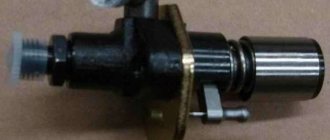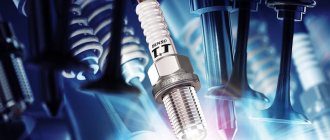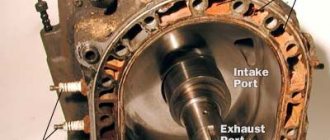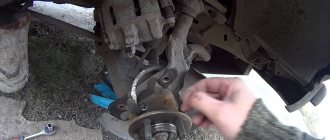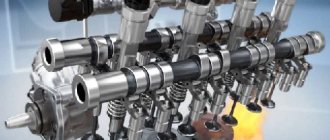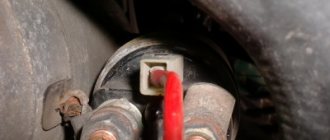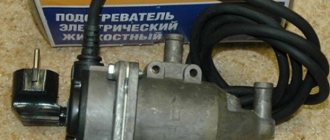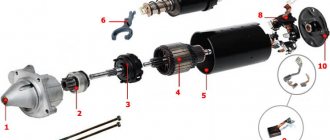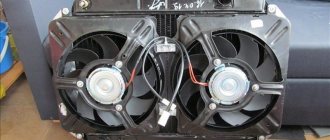The car engine starting system performs the initial rotation of the internal combustion engine crankshaft, as a result of which the fuel-air mixture in the cylinders ignites and the power unit begins to work independently.
The main task of the starting system is to rotate the crankshaft, which allows the piston to perform the compression of the mixture in the cylinders necessary to ignite the charge. Then the fuel ignites (from an external source in gasoline engines, from strong compression and heating in diesel engines).
Next, the crankshaft begins to rotate independently, that is, the engine starts, the crankshaft speed increases, and shaft rotation becomes possible due to the conversion of the thermal energy of fuel combustion into mechanical work. As soon as the crankshaft speed reaches a certain frequency, the starting system is automatically switched off.
In this article we will look at how the electric engine starting system works, what basic elements it consists of, and also talk about what other internal combustion engine starting systems there are, besides electrical solutions.
What is
Modern cars have an electric engine starting system. It is also often called a starter starting system. Simultaneously with the rotation of the crankshaft, the timing, ignition and fuel supply systems are switched on. The air-fuel mixture is burned in the combustion chambers and the pistons rotate the crankshaft. After reaching a certain crankshaft speed, the engine begins to work independently, by inertia.
Engine starting
To start the engine, you need to reach a certain crankshaft speed. This value differs for different types of engines. For a gasoline engine, the minimum required is 40-70 rpm, for a diesel engine - 100-200 rpm.
At the initial stage of the automotive industry, a mechanical starting system using a crank was actively used. It was unreliable and inconvenient. Now such solutions have been abandoned in favor of an electric starting system.
Car starting system purpose and technical requirements
The vehicle starting system is used for automatic remote engine starting and consists of a starter, an engagement mechanism, an electromagnetic relay and an auxiliary relay. The main technical requirements for the starting system are:
- reliable operation of the starter at 40-50 thousand kilometers;
- reliable operation of the starter when starting up to a temperature of 15°C
- reliable operation of the engagement mechanism and electromagnetic relays;
The electrical wiring for the starter and relay power supply is securely attached. Starters, for example, for cars ST 29.3708, ST 230-62, for trucks ST 142 B, ST 130 B consume current from 550 to 850 A with a rotation speed of up to 5 thousand min-1 with a subsequent reduction in current to 80-100 A.
Engine starting system device
The engine starting system includes the following key elements:
- control mechanisms (ignition switch, remote start, Start-Stop system);
- accumulator battery;
- starter;
- wires of a certain cross-section.
Engine starting circuit
The key element of the system is the starter, which, in turn, is powered by the battery. This is a DC motor. It creates torque, which is transmitted to the flywheel and crankshaft.
How does engine starting work?
After turning the ignition key to the “start” position, the electrical circuit is closed. The current through the positive circuit from the battery is supplied to the winding of the starter traction relay. Then the current passes through the field winding to the positive brush, then through the armature winding to the negative brush. This is how the traction relay works. The movable core retracts and closes the power pins. When the core moves, the fork extends, which pushes the drive mechanism (Bendix).
After the power nickels are closed, starting current is supplied from the battery through the positive wire to the stator, brushes and rotor (armature) of the starter. A magnetic field appears around the windings, which sets the armature in motion. In this way, the electrical energy from the battery is converted into mechanical energy.
Operation of the starter turned off and on
As already mentioned, the fork, during the movement of the retractor relay, pushes the bendix towards the flywheel crown. This is how engagement occurs. The armature rotates and drives the flywheel, which transmits this movement to the crankshaft. After starting the engine, the flywheel spins up to high speeds. To avoid damaging the starter, the Bendix overrunning clutch is engaged. At a certain frequency, the bendix rotates independently of the armature.
After starting the engine and turning off the ignition from the “start” position, the bendix returns to its original position, and the engine runs independently.
Types of starters
As described above, modern starters do not use shoes with an excitation winding, but magnets. Magnets as a stator can significantly reduce the dimensions of the device. In this case, the rotation speed of the armature increases. Therefore, a gearbox is sometimes used.
Based on this, starters are divided into:
- gear;
- simple (gearless).
We have already become familiar with the structure and operation of a simple starter. The operation of a gearbox is based on the same principles as a simple one, but has a slightly different device. The torque from the armature first goes to the planetary gearbox, which converts it, and then to the bendix shaft. Rotation from the armature to the gear is transmitted through the planetary gear carrier.
This type of starter has the following advantages:
- higher efficiency;
- less current consumption;
- small sizes;
- starting the engine even when the battery charge is low.
But this design affects the complexity of repairs.
Features of battery operation
Successful engine starting will depend on the condition and power of the battery. Many people know that such indicators as capacity and cold cranking current are important for batteries. These parameters are indicated on the marking, for example, 60/450A. Capacity is measured in Amp-hours. The battery has low internal resistance, so it can deliver large currents for a short time, several times its capacity. The specified cold cranking current is 450A, but subject to certain conditions: +18C° for no more than 10 seconds.
However, the current supplied to the starter will still be less than the specified values, since the resistance of the starter itself and the power wires is not taken into account. This current is called inrush current.
Reference. The internal resistance of the battery is on average 2-9 mOhm. The starter resistance of a gasoline engine is on average 20-30 mOhm. As you can see, for proper operation it is necessary that the resistance of the starter and wires be several times higher than the resistance of the battery, otherwise the internal voltage of the battery during startup will drop below 7-9 volts, and this should not be allowed. When current is applied, the voltage of a working battery drops to an average of 10.8V for a few seconds, and then recovers again to 12V or slightly higher.
The battery supplies starting current to the starter for 5-10 seconds. Then you need to pause for 5-10 seconds for the battery to “gain strength”.
If, after attempting to start, the voltage in the on-board network drops sharply or the starter cranks halfway, this indicates a deep discharge of the battery. If the starter makes characteristic clicks, then the battery is completely dead. Other reasons may include a broken starter.
Which autorun block to choose
Before purchasing a unit, you need to determine what features you need and how much you are willing to pay for them. If you already have some kind of alarm system, it is advisable to find an autostart unit that is compatible with it. This will avoid serious alterations to the vehicle's electrical wiring. If you have an outdated alarm system installed, which only provides a sound signal when there is an attempt to break into or steal, then it makes sense to install an autostart combined with the alarm.
Blocks that expand the capabilities of alarms will cost significantly less than individual devices. For example, the Pandora RMD-8 relay module, compatible with most Pandora alarm systems, will cost 2-3 thousand rubles. The module provides reliable starting and control of the operation of both gasoline and diesel engines. It is connected to the vehicle's standard CAN bus, so no major wiring modifications are required.
More functional units with a GSM module will cost 5-10 thousand rubles. For example, the cost of the Starline M31 module is 8-10 thousand rubles. The module works both with Starline alarms and independently. When using the module independently, it to some extent performs the functions of a car alarm. Thanks to the built-in GPS unit, the module informs about the location of the car, turning the engine on and off, and allows audio and video monitoring of what is happening in the cabin. To control the module, use a phone, tablet or other device that works with the appropriate SIM card. The presence of three redundant module inputs allows you to connect door sensors, vibration sensors or other devices to them. The only drawback of GSM modules is the need to pay for traffic. If the module is used only in SMS exchange mode, then the monthly payment will be noticeably lower, but the functionality will also decrease. If the module operates in constant communication mode, then the payment will be higher, but the module itself will be able to perform a greater number of functions, including the ability to control the car in real time.
If you need a full-fledged alarm system with an autostart function, then Starline D94 GSM Slave is a good option. This alarm will cost 20-25 thousand rubles. The alarm is equipped with a built-in vibration, jacking and theft sensor. The alarm system supports the connection of a large number of third-party sensors, which improves security control. The built-in GSM module allows you to control the alarm not only using the standard key fob, but also through the corresponding application on your phone, smartphone or tablet. The alarm is installed on modern cars equipped with a CAN bus. The only drawback of the alarm is the lack of a GPS/GLONASS module, which makes it impossible to track the vehicle's location.
If for some reason the GSM module or alarm system is not suitable for you, pay attention to traditional devices that use a radio channel. For example, Starline A91 Dialog
The cost of the alarm is 6-9 thousand rubles. The key fob provides stable communication with the alarm system at a distance of up to 250 meters. All information about the condition of the car is transmitted to the key fob and displayed using an LCD indicator. The presence of additional executive channels allows you to connect various devices. For example, a mirror control module, a pre-heater or an electric drive that regulates the height or position of the seats.
Current strength at start
Starters for gasoline and diesel engines will differ in power. For gasoline internal combustion engines, starters with a power of 0.8-1.4 kW are used, for diesel engines - 2 kW and higher. What does it mean? This means that a starter with a diesel engine needs more power to rotate the crankshaft into compression. A 1 kW starter consumes 80A, a 2 kW starter consumes 160A. Most of the energy is spent on the initial rotation of the crankshaft.
The average starting current for a gasoline engine is 255A for successful cranking, but this takes into account a positive temperature of 18C° or higher. At sub-zero temperatures, the starter needs to turn the crankshaft in thickened oil, which increases resistance.
Tips and tricks
The engine start button works in such a way that the driver presses it and holds it for the required time to start. During this period of time, the starter rotates the crankshaft, resulting in the engine starting. Then the button can be released.
Note that when choosing a “start-stop” engine start button, a number of certain nuances should be taken into account. One of these points is the issue of fixing this button. The optimal option is when, after pressing, the contacts are closed, and when released, they open. If the button has a lock, then after starting the engine, you will need to quickly press it again to open the contacts.
As for the button itself, there are many available solutions available for free sale, which differ in quality, price and other characteristics. These buttons can be backlit and made of plastic or metal.
For these reasons, it is worth considering when choosing:
- a strong current will be supplied to the button;
- the solution will be constantly used;
Taking into account these operating features, it is better to choose an engine start button with a high-quality external coating (for example, chrome plating). Such a product will have abrasion resistance to maintain an acceptable appearance
You also need to understand that cheap offers can burn out after just a few clicks, so this aspect should be given special attention
Features of starting the engine in winter conditions
In winter it can be difficult to start the engine. The oil thickens, which means it is more difficult to turn it. The battery also fails frequently.
At sub-zero temperatures, the internal resistance of the battery increases, the battery drains faster, and is also reluctant to deliver the required starting current. To successfully start the engine in winter, the battery must be fully charged and not frozen. Additionally, you need to monitor the contacts on the terminals.
Here are some tips to help start your engine in winter:
- Before turning on the starter when cold, turn on the high beams for a few seconds. This will start chemical processes in the battery, so to speak, “wake up” the battery.
- Do not turn the starter for more than 10 seconds. This way the battery drains quickly, especially in the cold.
- Depress the clutch pedal fully so that the starter does not have to turn additional gears in the viscous transmission oil.
- Sometimes special aerosols or “starter fluids” that are injected into the air intake can help. If the engine is in good condition, it will start.
Thousands of drivers start their engines every day and go on business. Getting started is possible thanks to the coordinated operation of the engine starting system. Knowing its structure, you can not only start the engine in a variety of conditions, but also select the necessary components in accordance with the requirements specifically for your car.
Basic faults
All possible types of starter malfunctions can be divided into mechanical and electrical.
Mechanical components may be associated with:
- Contact pads sticking.
- Wear of bearings and retaining bushings.
- Wear of bendix rollers.
- The plug or the solenoid relay core is jammed.
Electrical problems:
- Production of brushes and commutator plates.
- Open circuit in the winding of the shoes (stator) or the solenoid relay.
- Short circuit and burnout of windings.
The brushes and solenoid relay cannot be repaired. These parts are replaced with new ones. It is better to entrust winding repairs to a qualified auto electrician.
The starter is a rather complex mechanism that requires attention from the driver. It is better to eliminate any noises and rattles promptly. But despite the overall complexity of the device, the principle of its operation is very simple. Once you understand it, you can fix many problems yourself.

